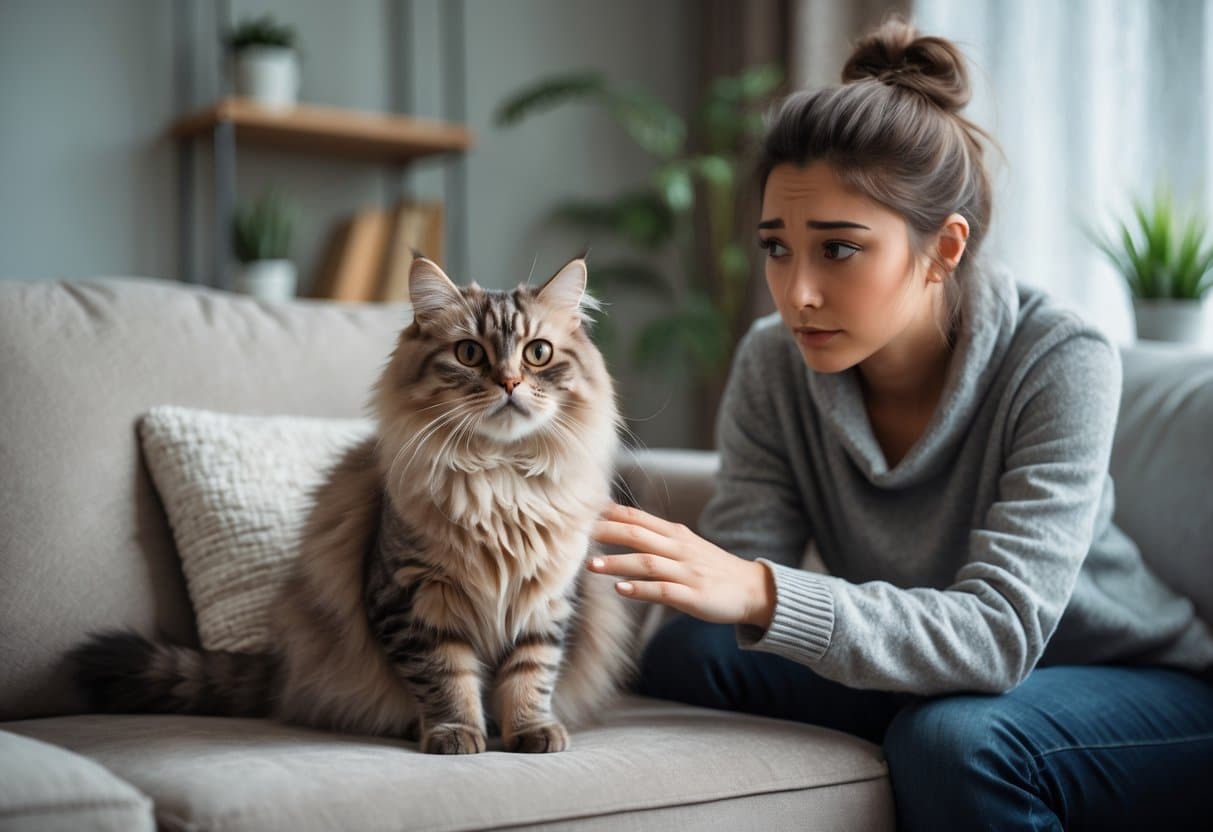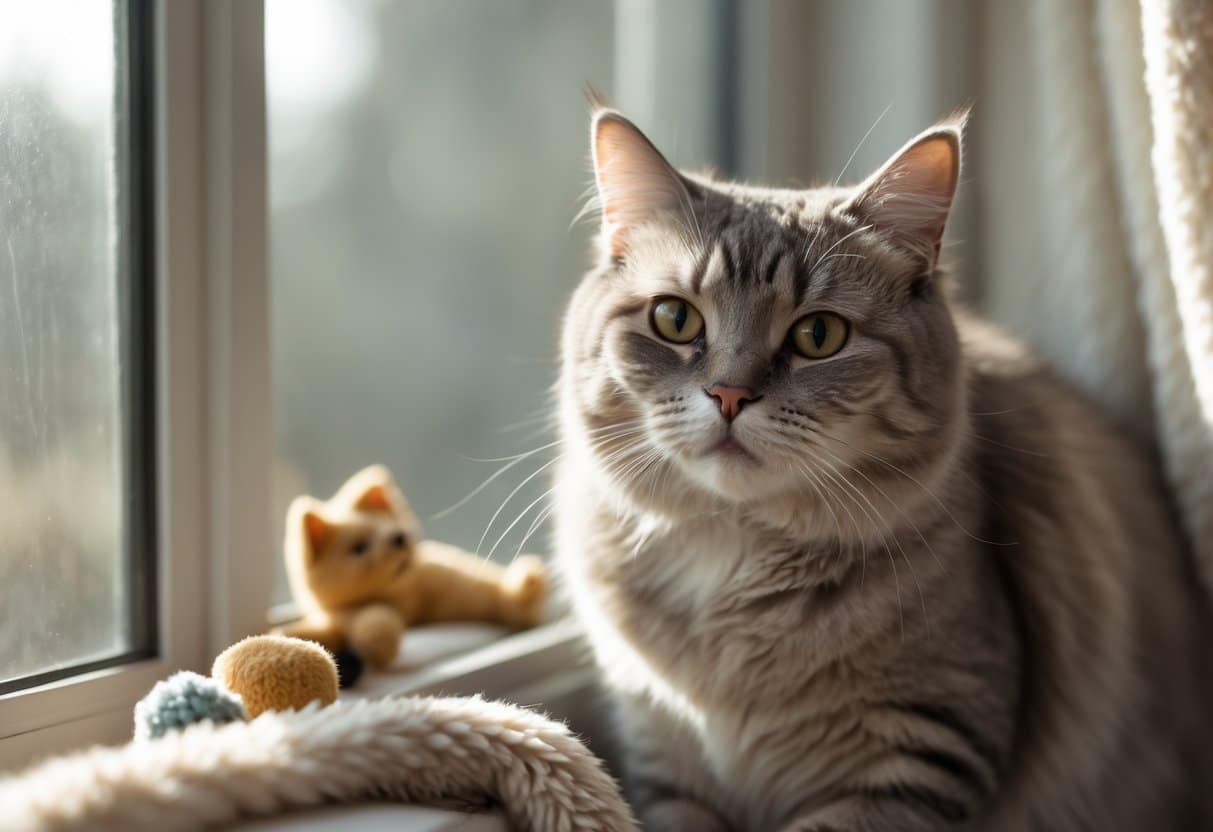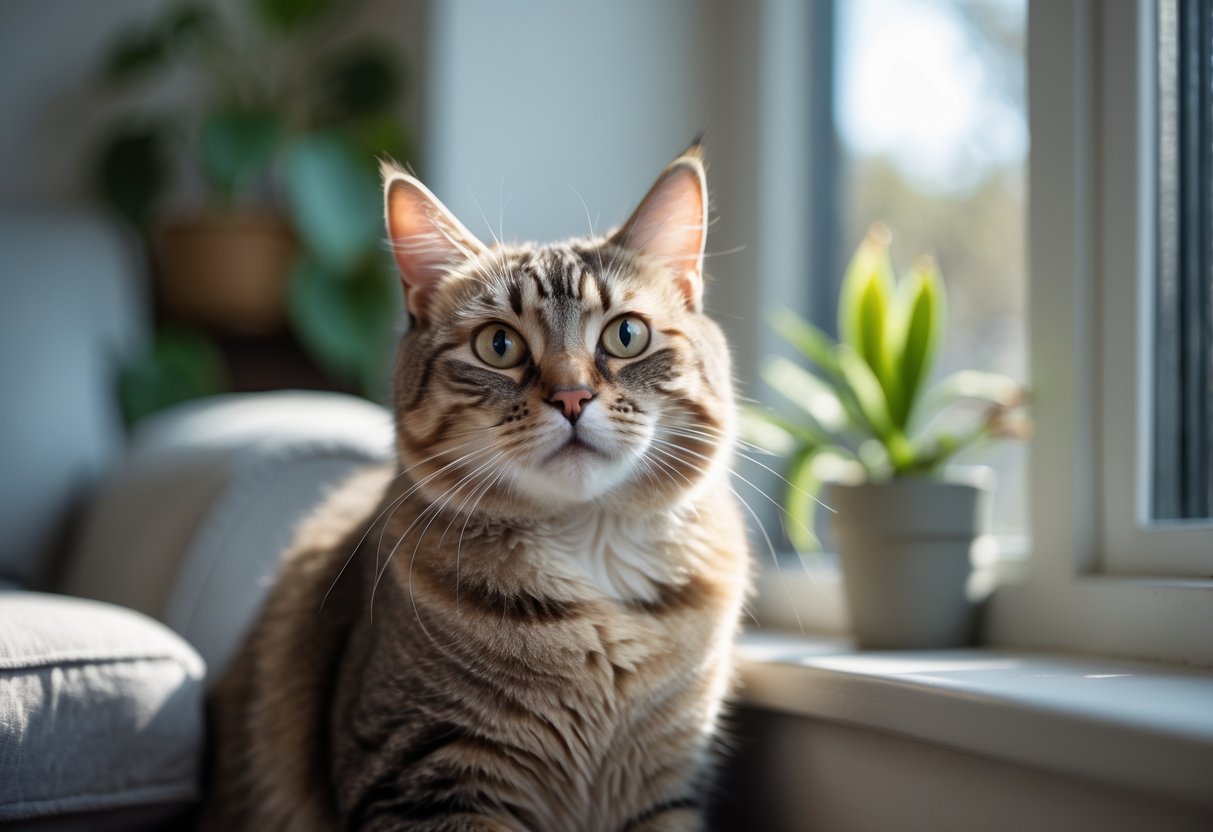
When your cat suddenly gets clingy and chatty, they’re usually trying to tell you something. Sudden neediness and vocalization can be linked to changes in health, environment, or emotional state.
Some cats are naturally more affectionate or vocal, but if you notice a real shift, it’s worth paying attention. There’s usually a reason behind the change.
Maybe they’re hungry, bored, anxious, or even hurting somewhere. Certain breeds like Siamese are famous for being talkative, but honestly, any cat can get loud or clingy if something’s up.
Understanding these signals can help you figure out if the cause is medical, emotional, or just a plea for attention. It’s not always obvious, but it’s usually not random.
Watch their body language, listen to their meows, and think about what’s changed in your home lately. Sometimes, just catching the problem early makes a big difference for both of you.
Key Takeaways
- Sudden clinginess or vocalization often signals a change in health or environment
- Breed traits and personality can influence how much a cat seeks attention
- Observing patterns and triggers helps address the cause effectively
Understanding Sudden Changes in Cat Behavior
Sudden shifts in a cat’s behavior can signal changes in their physical health, emotional state, or environment. Cats show these changes through increased closeness, new vocal patterns, or habits that just feel off.
Recognizing Clingy and Vocal Cat Behaviors
A needy cat might start following you everywhere, asking for constant petting, or suddenly insisting on sitting right next to you. Even cats that usually keep to themselves can flip this switch overnight.
Vocalization can range from gentle meows to yowling that you just can’t ignore. When this starts out of nowhere, it’s often a sign they’re uncomfortable, stressed, or seeking reassurance.
Some cats combine clinginess and meowing—think rubbing against your leg while pacing and talking. This combo often points to things like illness, anxiety, or even something as simple as wanting more attention.
Jotting down when and how often the behavior happens can actually help you spot patterns. It’s a bit of detective work, but worth it.
Common Communication Methods in Cats
Cats use a bunch of ways to talk to us and to other animals. These include:
| Method | Possible Meaning |
|---|---|
| Meowing | Requesting food, attention, or help |
| Purring | Contentment, or sometimes pain relief |
| Chirping/Trilling | Greeting or excitement |
| Hissing/Growling | Fear, discomfort, or warning |
| Body posture | Mood or intent |
| Tail position | Confidence, curiosity, or agitation |
Vocalization often changes with age, environment, and health. If your cat suddenly gets more vocal and you can’t figure out why, they might be trying to tell you something’s wrong.
Watching their body language—ears, tail, posture—along with the sounds they make helps you get the full picture.
When to Be Concerned About Behavior Changes
Not every sudden change is an emergency, but some are. If your quiet cat turns into a nonstop talker, or your independent kitty won’t leave your side, it might mean illness or stress.
If you see vocalization alongside lethargy, appetite loss, vomiting, or hiding, don’t wait—get a vet involved. Sometimes it’s just a blip, but other times it’s a red flag.
Big environmental changes like moving or new pets can also trigger these behaviors. If things don’t settle down after a while, it’s worth digging deeper.
For more info, check out this guide on why cats become needy all of a sudden.
Medical Reasons for Increased Neediness and Vocalization
If your cat is suddenly more vocal and clingy, their body might be trying to get your attention. Illness, pain, or even just getting older can change how they act.
Especially with senior cats, these changes can sneak up on you. Sometimes you only notice when the behavior gets really obvious.
Pain, Illness, and Discomfort
Cats are experts at hiding pain, but sometimes their behavior gives them away. Dental disease, urinary tract infections, or arthritis can make them meow more or stick close to you for comfort.
Chronic kidney disease or diabetes can also make cats vocal, usually because they’re thirsty or hungry all the time. Even tummy troubles or minor injuries can cause similar shifts.
Common medical triggers include:
- Pain-related conditions: arthritis, injuries, dental problems
- Metabolic disorders: diabetes, hyperthyroidism
- Internal discomfort: urinary tract infections, constipation
If your independent cat turns needy overnight, booking a vet visit is smart. Catching things early can save a lot of trouble down the road.
Age-Related Health Issues
Older cats start to run into health problems that can mess with their behavior. Hyperthyroidism, cognitive issues, or heart disease can slowly ramp up the vocalizing and clinginess.
Hyperthyroidism, for instance, often comes with restlessness, a bigger appetite, and lots of loud meowing. Cognitive decline can make older cats confused, especially at night, so they look for reassurance.
Age-related concerns to watch for:
- Increased pacing or wandering
- Vocalizing at odd hours
- Changes in sleep or eating
Regular check-ups for senior cats help catch these problems early. Bloodwork, exams, and tracking their weight are all part of keeping them healthy.
Sensory Decline: Hearing and Vision Loss
Losing hearing or vision can make cats feel vulnerable, so they stick closer to you. If they can’t see or hear well, they might meow more just to make sure you’re around.
Vision loss can be from cataracts, glaucoma, or retinal problems. Hearing loss is usually age-related but sometimes comes from ear infections.
Signs of sensory decline include:
- Jumping at sudden touches
- Bumping into things
- Louder or more frequent meowing
Keeping their environment predictable helps. Try not to move furniture, and use gentle touch or even vibrations to let them know you’re there.
Emotional and Environmental Triggers
Sometimes, a clingy cat is just reacting to stress or changes at home. Stuff like anxiety, new routines, or losing a buddy can make them louder and more attached.
Stress and Anxiety in Cats
Cats are surprisingly sensitive to stress. Even small things—like loud noises or guests—can throw them off and make them seek comfort from you.
Sometimes it’s something you wouldn’t even think of, like strange smells or a new dog barking outside. A stressed cat might follow you, meow nonstop, or want to be held more.
Safe spaces, like quiet rooms or high-up perches, can help. Toys, regular feeding times, and even pheromone diffusers or calming treats can work wonders for some cats.
Changes in Household or Routine
Cats love routine—maybe even more than we do. Change their feeding time, move the litter box, or rearrange where they sleep, and you might see clingy behavior pop up.
Big changes, like moving or a new pet, can really shake them. Even just a new work schedule can throw them for a loop and make them more vocal.
Try to keep routines steady. Use familiar bedding, toys, and feeding spots. And if you have to make changes, do it slowly so your cat can adjust without too much stress.
Loss of a Companion
Losing a pet or person in the household can hit cats hard. They might become extra vocal, shadow you everywhere, or seem afraid to be alone.
Some cats even stop eating or lose interest in play after a loss. Giving them more affection and sticking to routines can help them bounce back.
In homes with multiple pets, everyone’s social dynamic can shift. Watch for signs of withdrawal or depression—sometimes a vet or extra enrichment activities are needed to help them cope.
Feline Cognitive Decline and Senior Cat Behavior

As cats get older, their brains change. Memory, learning, and daily routines can all be affected, sometimes leading to confusion or odd sleep habits.
Signs of Cognitive Dysfunction
Feline cognitive decline, or feline cognitive dysfunction (FCD), usually shows up in senior cats over 10. It can mess with memory, awareness, and problem-solving skills.
Common signs include:
- Disorientation – getting lost in familiar areas or staring into space.
- Litter box changes – forgetting its location or eliminating in sleeping/eating areas.
- Altered social behavior – becoming clingy or avoiding contact.
- Sleep-wake changes – sleeping more during the day and vocalizing at night.
Some cats pace, vocalize urgently, or seem not to recognize people they know. These behaviors can look like other medical problems, so it’s smart to have a vet rule out things like arthritis, vision loss, or thyroid issues before pinning it on feline cognitive dysfunction.
Managing Cognitive Decline in Older Cats
FCD isn’t curable, but you can often ease symptoms with a few lifestyle tweaks. Keeping a consistent daily routine really helps—try not to move food bowls, litter boxes, or sleeping spots around.
Offer multiple, easy-access litter boxes with low sides, especially for cats struggling to get around. If your cat gets lost or anxious, you might want to limit their space to one floor or room.
Boost mental stimulation with gentle play, puzzle feeders, or even short training sessions. For those nighttime wanderers, get them playing during the day so they’ll (hopefully) sleep better at night.
Sometimes, vets suggest meds like selegiline, anti-anxiety drugs, or pheromone diffusers to help manage anxiety and confusion in senior cats. Regular checkups help catch any new or worsening symptoms early.
Breed and Personality Factors

Some cats are just naturally more vocal or clingy, thanks to their breed or their own quirky personalities. Genetics, early life, and how much they were socialized as kittens all play a part in how much attention a cat craves.
Cat Breeds Prone to Clinginess
Certain cat breeds are famously people-oriented. Siamese cats, for example, love to “talk” and stick close to their people. Ragdolls are the ultimate lap cats and often want to be near you all day.
Burmese and Tonkinese cats also form tight bonds and can get upset when left alone. They’re more likely to meow for attention and want lots of physical closeness.
Some breeds, like the Maine Coon, might not be as chatty but still show clingy behavior by being your shadow. Breed tendencies aren’t a guarantee, but they do stack the odds toward neediness.
If you have one of these breeds, be ready to give them regular play, interaction, and mental challenges to keep them happy and prevent stress or boredom.
Individual Personality Differences
Even among the same breed, personalities can be wildly different. A cat’s early socialization and past experiences shape how cuddly or vocal they’ll be.
Cats raised by hand or bottle-fed often bond more deeply with people. Rescue cats who’ve been through rough times sometimes become extra clingy once they feel safe.
Some are just naturally nosy and social, always looking for something to do with you. Others act needy after big changes, like moving, a new pet, or losing a companion.
Knowing your cat’s background helps make sense of their behavior. Adjusting routines, adding enrichment, and keeping things stable can help a clingy cat without making them overly dependent.
Attention-Seeking and Learned Behaviors
Cats are quick studies—if something works, they’ll do it again. If your cat figures out that meowing or tailing you around gets your attention, they’ll keep it up. This goes for both naturally needy cats and those suddenly acting more vocal.
Attention-Seeking Patterns
Attention-seeking shows up in all sorts of ways. Maybe your cat follows you everywhere, paws at you, or plops in your lap while you work. Some even knock stuff over or block your path just to get noticed.
They might be bored, lonely, or just want some predictability. If a cat expects playtime at a certain hour, they’ll get louder or clingier if you’re late.
Patterns form fast. If you give in to meowing near the food bowl, expect a repeat performance every day. Tracking these habits can help you spot triggers and tweak routines. Structured play and enrichment, like this guide from cats.com suggests, can cut down on disruptive habits.
Reinforcement of Vocalization
Vocal cats often get that way because we reinforce it—sometimes without realizing. If a cat meows and gets food, petting, or even a glance, they learn it works. Even scolding can count as attention.
Eventually, this can turn soft meows into loud yowls if that’s what gets results. To break the cycle, ignore the unwanted meows and reward quiet, calm moments instead.
Give attention when your cat is relaxed so they learn being quiet pays off, too. Consistency is key for changing these habits and building better communication.
How to Respond and Support Your Cat
If your cat suddenly gets clingy and vocal, it might mean something’s up—health, environment, or just emotional needs. Figuring it out means checking for medical issues, improving their space, and building trust so they feel safe.
Veterinary Consultation and Health Checks
Sudden changes in behavior—like more clinginess or loud meowing—can point to medical problems. Things like arthritis, hyperthyroidism, or urinary issues can make cats uncomfortable and lead to attention-seeking.
A vet can check them over, run some bloodwork, and look for pain or illness. Catching things early can stop the problem from getting worse and might even fix the clinginess.
It’s a good idea to keep up with regular wellness visits even if your cat looks fine. That way, you’re on top of weight, dental stuff, and organ health. Vaccinations and parasite prevention matter, too.
If your cat’s suddenly clingy or loud, don’t wait—get them checked out soon.
Environmental Enrichment and Routine
Cats need a stimulating, predictable environment to feel good. A bored or under-stimulated cat might get needy or noisy just for attention.
Try offering interactive toys, scratching posts, and places to climb. Puzzle feeders are great for keeping minds busy and satisfying hunting urges.
Stick to a daily routine for meals, play, and downtime. Cats relax when they know what to expect.
Set up cozy spots by windows or in quiet corners so your cat can choose between hanging out with you or getting some alone time. This can help cut down on the constant following or meowing.
Building a Secure Bond
Some cats get needy because they’re looking for reassurance. Building trust can really help tone down the extra meowing and clinginess.
Spend short but frequent quality time with your cat—gentle petting, interactive play, whatever they like. This meets their social needs without rewarding demanding behavior.
Reward calm, independent moments with treats or praise. If you ignore excessive meowing (but still meet their basic needs), your cat will eventually catch on.
Soft speech and slow, predictable movements go a long way. Cats pick up on these cues and feel safer, which only strengthens your bond.
Frequently Asked Questions
When cats suddenly get clingy or vocal, it’s often about changes in health, emotions, or what’s going on around them. Illness, hormonal shifts, or even household changes can set things off.
Sometimes, cats just mirror their owner’s routines or moods. They’re more tuned in than we give them credit for.
What causes a female cat to become unusually clingy?
A female cat might get more clingy due to hormonal changes, like during heat cycles or pregnancy.
Stressful changes—moving, a new pet, whatever—can also have her seeking extra comfort from you.
Can a male cat’s sudden clinginess indicate a health issue?
Absolutely. If a male cat suddenly gets needier, he might be dealing with pain or illness.
Stuff like hyperthyroidism, dental pain, or kidney disease can all make a cat act different—more vocal, more attached. A vet visit is definitely in order.
What does it mean when a cat becomes more affectionate and clingy than usual?
More affection usually means your cat needs reassurance or is feeling a bit insecure.
Sometimes, it’s just age—they want more company as they get older. Or maybe your bond has grown stronger over time.
Is there a reason my cat has started to become clingy and bite me?
Some cats mix snuggles with gentle biting—those so-called “love bites.”
But if your cat suddenly starts biting while being clingy, it could mean they’re overstimulated or a bit irritated. Watching body language helps avoid those nips.
Why does my cat exhibit clingy behavior specifically during the night?
Cats are naturally more active at night, so some will look for attention then—maybe out of boredom or just habit.
If your cat’s alone during the day, they might want to make up for lost time once you’re home and winding down.
Could my cat’s sudden clinginess be a sign that I am pregnant?
Some cats seem to pick up on subtle shifts in their owner’s scent or behavior during pregnancy.
Not every cat will react, but a few might suddenly act more protective or glued to your side. Maybe it’s the hormones, or just the general shake-up in the daily routine—who knows?




